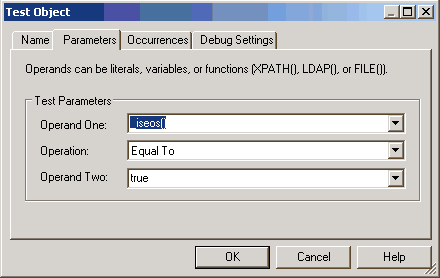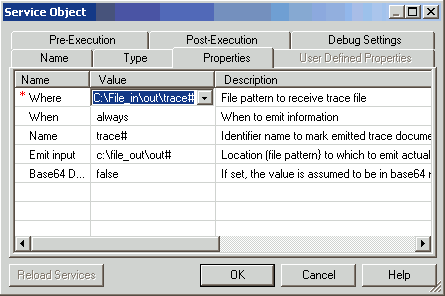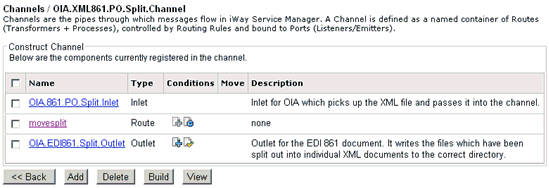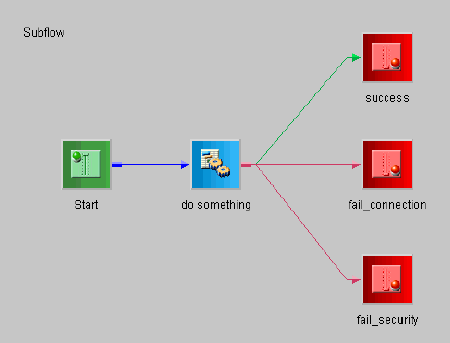Document functions access information pertaining to
the current document being processed.
x
_isroot(): Tests element root
The _isroot() function returns 'true' if the root of
the current document matches the parameter. It uses the following
format:
_isroot(name)
name | string | Name to be compared to the root element |
The _isroot() function is often used to drive a routing decision,
such as _root('a') or _root('b') to cause the route to be selected
for any document with a root of 'a' or 'b'.
x
_root(): Returns the root element name
The _root() function returns the root element name of
the current document. It uses the following format:
_root()
This is equivalent to the _xpath function _xpath(/*/name()).
It might be used in a routing decision, such as _cond(_root(),eqc,'a')
which selects the route for documents with roots of 'a' or 'A'.
x
The current document can hold either XML or non-XML
information. The _isxml function returns true if the current document
holds XML. If the document has no contents, this function returns
false. It uses the following format:
_isxml()
x
_isflat(): Test for Non-XML
The current document can hold either XML or non-XML
information. The _isflat function returns true if the current document
holds non-XML. If the document has no contents, this function returns
false. It uses the following format:
_isflat()
x
_iserror(): Is the Document in Error State?
The current document can have errors posted to it by
the system, or can be set into an error state by the actions of
an application process. If the document is in error state, default
replies are delivered to the configured error addresses, otherwise
they are delivered to the configured reply addresses. The _iserror()
function returns true if the document is in error state. It uses
the following format:
_iserror()
x
_inflate(): Inflate a Value
_inflate(value , type)
value | string | The string inflate |
type | mnemonic | Type of input: “base64”, “string” |
The input is assumed to be a string version produced from a deflated
message. How the string is created will depend on the input document,
but can be expected to be either a base64 value or a string simply
made from a byte array. Users are cautioned that if the input is
in base64 format, do not attempt to use the _frombase64() function
to preconvert the input to string. Doing so can result in loss
of information.
The standard ZIP inflate algorithms are attempted, and if successful
the result returned is the inflated string.
x
_hasruleerr(): Test for Rule Violations
As the document passes through its execution route,
a supplied rules-based validation system can be employed. Often
the rules relate to eBusiness documents suchas SWIFT or EDI. If
the rules system has posted a validation error to this document,
the _hasruleerr() returns true. It uses the following format:
_hasruleerr()
x
_hasschemaerr(): Test for Schema Rule Violations
During a document's life in the system, certain rules
and services can detect schema violations. Whether such a violation
has been detected can be tested with this function. A common use
of this function is in a process flow test object. This function uses
the following format:
_hasschemaerr()
x
_iswellformed(): Test for XML
The current document can hold either XML or non-XML
information. This function returns true if the current document
holds XML or holds flat information that can be parsed into XML.
If it has not been parsed, a true response from this function assures that
the message can be parsed into XML. It uses the following format:
_iswellformed()
x
_iseos(): Is Document at End of Stream
Streamable input is used for handling large documents
or documents for which the application desires to "split" the input
into sections under the same transaction. Following the completion
of the input stream handling, a "final pass" is made with a special document
containing batch information:
<batch count='n'/>
The end of stream can also be tested with the_iseos() function.
A common use of this function is in a process flow test object.
This function uses the following format:
_iseos()
Creating a Process Flow to Test for an End of Stream Document
Splitting and streaming/splitting preparsers generate a special
control document at the end of a batch to indicate that this batch
was completely processed. This End of Stream document is
a non-data XML document that is passed into a channel after all data
documents. The _iseos() function will return as true if the
current document contains an End of Stream message, else it will
return as false. The End of Stream document may also contain
additional statistics about the splitting process, such as how many
iWay documents were generated from the batch.
To create a process flow using iWay Designer to test for an End
of Stream document:
- Create
a process flow and add a new Test object.
- Configure
the parameters for this Test object, as shown in the following image.

- Add a new
Service object to the process flow that uses the QAAgent.
- Configure
the parameters for this Service object, as shown in the following
image.

- Connect the
Service object to the True edge of the Test object.
The new process
flow should have a structure that resembles the example in the following
image.
- Using the
iWay Service Manager Administration Console, create a channel that consists
of an XMLSplitpreparser as an inlet, which would return an End of
Stream document when the last pass is reached.
- Add a route
to the channel that consists of the process flow, which was created using
iWay Designer.
- Add an outlet
to the channel.
The new channel should have a structure that resembles
the example in the following image.
- Use the following
input document to test your channel with /a/b as the level string:
<a>
<b name="b1">
<c>value of input element a/b@name=b1/c is 1</c>
<c>value of input element a/b@name=b1/c is 2</c>
</b>
<b name="b2">
<c>value of input element a/b@name=b2/c is 3</c>
<c>value of input element a/b@name=b2/c is 4</c>
</b>
</a>The _iseos() functions returns as true at
the third (last) pass and a trace file is created which displays
the End of Stream document.
x
_xpath: Execute an XPATH Expression
The xpath() function is always an alias for one of the
supported xpath functions: xpath1() or _iwxpath(). By default, xpath()
is an alias for _iwxpath() but via compatibility flags it can be
made to alias xpath1().
The _xpath() function uses the following format:
_xpath(expression [,nsmap [,object]])
x
_xpath1: Execute an XPATH Expression
The document is evaluated by the provided xpath expression.
The start is always considered to be the root, so all expressions
are assumed to begin with '/'.
The purpose of the xpath in the context of functions is to extract
values from an input document to be used as configuration parameters.
This use of xpath is not intended for general XML tree manipulation.
In some servers, xpath is a full xpath version 0 as specified
by XML Xpath Language http://www.w3.org/TR/1999/REC-xpath-19991116,
while others support only the portion of xpath specified in section
2.5, Abbreviated Syntax.
The _xpath1() function uses the following format:
_xpath1(expression [,nsmap [,object]])
expression | string | Expression in xpath language. |
nsmap | string | Name of a namespace map from
a provider. If omitted, no namespace map is applied. |
object | document | A document to which xpath is applied. If
omitted, the current document is evaluated. |
Note: In iWay Service Manager version 6.0.1 and lower,
the _xpath() function has a single parameter, since namespaces are
not supported.
x
_xflat: Generate a Subtree
The _xflat() function uses the following format:
_xflat(expression)
expression | string | Expression in xpath language. |
Note: In iWay Service Manager version 6.0.1 and lower,
the _xflat() function has a single parameter, since namespaces are
not supported.
The current document is evaluated by the provided xpath expression.
As with xpath, the root of the current document is the "starting
point". The sub tree addressed by this expression is returned in
a flattened form suitable for reparsing.The parameters are as discussed
under xpath(). This function is often used to provide "document
segments" in the constant value service leading into a join. For
example:
<a>
<top>
<b>one</b>
<b>two</b>
<x>
<xroot>
<xchild>rootchildvalue</xchild>
</xroot>
</x>
</top>
</a>The expression _xflat(//xroot) yields the following subdocument:
<xroot>
<xchild>rootchildvalue</xchild>
</xroot>
x
_flatof: Flatten the tree
The current document is flattened. If the current document
is XML, the decl parameter determines whether an XML declaration
will be included in the flattened output. The default is true. The
_flatof() function uses the following format:
_flatof([decl])
decl | boolean | Is an XML declaration desired? |
x
_attcnt: Index Attachments
Documents can hold attachments. This function has two
forms. When used with no parameters, it returns the number of attachments
associated with the document. When used with two parameters, it
returns the index of the first attachment having the named header
equal to the specified value. The _attcnt() function uses the following
format:
_attcnt([name,value [,notfound]])
name | string | Name of an attachment header |
value | string | Value of the named header |
notfound | string | What to return if the named attachment header
is not found |
x
_atthdr: Attachment Header Value
The _atthdr() function returns the value of a specific
header in the attachment. The IC (independent case) form tests the
attachment header names in a case independent fashion. Number 0
is the first attachment. The _atthdr() function uses the following
format:
_atthdr(index, name, default)
_atthdric(index, name, default)
index | integer | Index of the attachment, base
0 |
name | string | Name of the header desired |
default | string | Default if header not found |
When the _atthdr() function is used in a conditional expression
in comparison against a string value, the default value must be
specified.
For example, the following conditional expression would not compile,
since it requires a default value in the expression:
COND(_atthdr(1,'mysample'),eq,'a')
Instead, the expression must be specified as follows:
COND(_atthdr(1,'mysample','defaultval'),eq,'a')
For example, to return the first header in the attachment, _atthdr(0,'mysample') could
be used.
x
_srcname: Source Name from Subflow
- _srcname()
-
Returns the name of the terminate (end node) of the subflow
through which the document reached the calling process flow. This
allows the subflow to communicate information back to the parent
flow.
Imagine a subflow that performs some operation that
results in one of three possible situations: success or a failure
caused by a security violation or a connection error.

The parent flow calls
the subflow, and wishes to deal with the result from that flow. Within
the subflow, the document that is produced is returned via a terminate
or end node, as shown. The name of that terminate node becomes the
edge name followed by the returned document. As this example shows,
there are three activities (called do_<something>) in the
outer flow, each of which handles the result returned from the inner
subflow.

If the subflow returns
multiple documents, each follows the edge of its own name. If more
than one of any name is returned, the documents are associated as
siblings, and can be split later using the sibling iterator. The
source name can be used in a switch statement for more detailed routing.
x
_iwxpath: Execute an XPATH Expression
_iwxpath(expression)
expression | string | Expression in xpath language |
The current document is evaluated by the
provided xpath expression. The start is always considered to be
the root, so all expressions are assumed to begin with '/'.
The
purpose of the xpath in the context of functions is to extract values
from an input document to be used as configuration parameters. This
use of xpath is not intended for general XML tree manipulation.
The
xpath language supported is specified in XML Xpath Language http://www.w3.org/TR/1999/REC-xpath-19991116,
section 2.5, Abbreviated Syntax.
In those servers not providing
full xpath support, both xpath and _iwxpath are identical. In other
servers, it can be expected at _iwxpath should operate faster than
full xpath. iWay recommends use of full xpath if _iwxpath does not
provide the required services or results.
x
_xpath1: Execute an XPATH Expression
_xpath1(expression [,nsmap [,object]])
expression | string | Expression in xpath language |
nsmap | string | Name of a namespace map from
a provider. If omitted, no namespace map is applied. |
object | document | A document to which xpath is applied. If
omitted, the current document is evaluated. |
The purpose of the xpath in the context
of functions is to extract values from an input document to be used
as configuration parameters. This use of xpath is not intended for general
XML tree manipulation.
The nsmap is the name of a namespace
provider. Namespace providers relate the namespace portion of the
xpath expression to the URI to which it relates. The xpath execution
engine will map the URI to the namespace tokens used in the document
being evaluated.
If the object parameter is omitted, the xpath
is applied against the current document. Otherwise this must be
the name of a special register holding a document or a register
itself holding a document.
In some servers, xpath is a full
xpath version 1 as specified by XML Xpath Language http://www.w3.org/TR/1999/REC-xpath-19991116,
while others support only the portion of xpath specified in section
2.5, Abbreviated Syntax. iWay 6.0 supports full XPATH per the specification.
In
some cases, XPATH syntax can be confusing. Consider a document
in a default namespace:
<root xmlns='http://someuri.com'>
<child name='whoami'/>
</root>A request for the child name would appear
to be //child/@name, and if there were no default namespace, this
would indeed work as expected. For the anonymous namespace, a solution
is 1:
The default namespace throws in a twist. The XPath specification
states the following:
A node test that is a QName is true
if and only if the type of the node (see [5 Data Model]) is the
principal node type and has an expanded-name equal to the expanded-name specified
by the QName.
This means that an XPath processor does
not deal with plain element names, except those element names for
which no namespace has been declared. If there is any namespace
declaration at all, including one for the default (unprefixed) namespace,
the processor uses the expanded-name.
//*[namespace-uri()="http://someuri.com" and local-name()="child"]/@name
Alternatively,
create a namespace provider name, for example, empty1. Add a specification
for a namespace such as:
Then use an _xpath statement such as the following:
_xpath(/none:root/none:child/@none:name,empty1)
The
processor will map the 'none' namespace to the URI in the statement
and select the proper nodes from the document.
x
XPATH Language support is an important feature of iWay
and is used in a number of areas within the server. XPATH is a non-procedural
language used to access and manipulate sections of an XML document.
The XPATH expression gathers information from the document, as if
the XML document is a self-contained hierarchical database. The
XPATH expression specifies levels (segments/fields), filter predicates,
and functions on the XML document data. The result of the XPATH
can be one or more values, a set of XML nodes, or a particular location
in the XML structure. Using these XPATH results, iWay Service Manager can
control the behavior of service agents, conditional routing, and
decision-making inside of process flows. iWay Service Manager implements
a subset of the XPATH location steps, predicates, and functions,
which are expressed using abbreviated syntax.
The fully proposed XPATH Language specification and information
on the abbreviated syntax can be found at:
http://www.w3.org/TR/xpath.html
x
Navigating XML With Location Steps
In iWay Service Manager, the node context from which
location steps begin is always the root of the document. Furthermore,
only the child axis is implemented and is implicit in all iWay XPATH
location steps.
x
Reference: Location Steps
|
Expression (phrase)
|
Action
|
|---|
|
/name
|
Locate down one level, selecting children
of the specified name.
|
|
//name
|
Locate down, selecting children of the specified
name regardless of the depth.
|
|
/*
|
Locate down, selecting all children.
|
|
//*
|
Locate down, selecting all children.
|
|
/.
|
Locate all nodes that are already selected.
|
|
/..
|
Locate upward one level, selecting the parent
of each node in the node-set.
|
The
result of the location step phrase can be a set of XML document
nodes consisting of zero, one, or many nodes. This set of nodes
is referred to as a node-set. This node-set
is provisional and may not be the final node-set returned by the
XPATH expression, depending on subsequent predicates.
x
iWay supports two XPATH processors with different characteristics; selecting
the right one for any specific situation can greatly improve the
performance of an application.
_iwxpath(). This is an XPATH processor provided by iWay.
It supports a limited subset of the XPATH language. If your document
and query are appropriate to using _iwxpath, you can expect to
achieve significant performance improvements. However, the limitations
of this process are:
-
Very limited function support.
-
No advanced “XPATH” features such as math.
-
Surrounding functions such as count() are not supported.
-
Conjunctions (such as OR and AND) and complex tests are
not supported.
-
Namespaces are not supported.
Note: For most applications, these omitted features are
not used. If _iwxpath() does not return the results you desire,
use _xpath1().
_xpath1(). This is the full XPATH. It may be slower for
certain operations, but it does provide the complete language support
of XPATH version 1.
_xpath(). This is the default xpath call. Whether it
calls _iwxpath() or _xpath1() depends on a configuration setting
on the iSM console.
In general, it is best practice to write your xpath expressions
as simply as possible. Avoid expressions that may return multiple
results when you are not expecting them. Select any (*) can slow
down any XPATH processor, as can use of //. Use these language constructs
if they are needed, but understand that there may be a penalty in performance.
x
Predicates are written after the location step, and
are enclosed in square brackets. There can be one or more predicates
in a step, each of which is applied left to right to control the
membership of the node-set.
A predicate filters the node-set implied by a location step,
to produce a new node-set. For each node in the node-set to be filtered,
the predicates are evaluated with that node; if predicate expression
evaluates to true for that node, the node is included in the new
node-set; otherwise, it is not included.
Multiple predicates are written as sequential predicate terms
and are applied left to right, behaving as if connected by a logical
"AND":
/Book[Author='Smith'][Price<10]
Each predicate term consists of a single integer, a filter function
or a relation of the form.
<left-value> operator <right-value>
A predicate can hold any number of terms, logically connected
by AND and OR. The specification calls for left to right precedence,
with AND taking higher precedence than OR. Terms may be grouped
by parenthesis to force a particular order of evaluation. For example, the
predicate [a=b OR c=d AND e=f] is evaluated as [a=b OR (c=d AND
e=f)].
Integer predicates of the form /Tag[2] imply a numeric index
into the current node-set (in this case, selecting the second node).
x
Reference: Comparison and Logical Operators
|
Symbol
|
Description
|
Example
|
|---|
|
=
|
Equal
|
//*[local-name(CustomerRecord/RecordDate)='OrderRecord']
|
|
!=
|
Not Equal
|
//*[local-name(CustomerRecord/RecordDate)!='OrderRecord']
|
|
<
|
Less than
|
/OrderRecord/LineItems[position() < 5]
|
|
<=
|
Less than or equal
|
/OrderRecord/LineItems[position() <=
5]
|
|
>
|
Greater than
|
/OrderRecord/LineItems[position() > 5]
|
|
>=
|
Greater than or equal
|
/OrderRecord/LineItems[position() >=
5]
|
|
Or
|
Logical Or
|
OrderRecord[salesman = 'Jones' or salesman='Scott]
|
|
And
|
Logical And
|
OrderRecord[salesman = 'Jones' and salesman='Scott]
|
|
Not
|
Logical Not
|
/a//*[not(starts-with(name(),'d'))]
|
x
Reference: Predicate (filter) Functions
|
Expression
|
Description
|
|---|
|
starts-with(string1, string2)
|
Returns true if the first string starts
with the second string, otherwise returns false.
|
|
ends-with(string1, string2)
|
Returns true if the first string ends with
the second string, otherwise returns false.
|
|
contains(string1, string2)
|
Returns true if the first string is contained
within the second string, otherwise returns false.
|
In
each of the preceding filter functions, string1 may be name(), @attribute,
@* (all attributes) or the name of the child node.
x
A collection of functions is provided to operate on
nodes and node-sets. A function operates on the current context
(for example, the current node) or on characteristics of the current
node-set, and returns a single value.
x
|
Function
|
Description
|
|---|
|
count(<node-set>)
|
Returns the number of nodes in the specified
node set.
|
|
last()
|
Returns the position number of the last
node in the context node-set.
|
|
position()
|
The position of a node in the node-set relative
to its parent.
|
|
count()
|
The number of children of each node in the
node set.
|
|
text()
|
Returns the value of each node in the node
set. Also used to return the value of CDATA.
|
|
name()
|
Returns the name of the nodes in the selected
nodeset. Example //sql/*/name() returns the names of the grandchildren
of each sql node.
|
|
local-name
|
Returns the local name of each node in the
node set.
|
|
sreg(name[,default])
|
The value of a named special register (iWay
extension to XPATH).
|
|
@attrib, @*
|
Returns the values of the specified attribute,
* returns the set of all attribute values.
|
|
concat(string1, string2)
|
Returns the concatenation of all its arguments.Two
or more strings may be concatenated.
|
|
Substring(string, position, length)
|
Returns the substring of the first argument
starting at the position specified in the second argument with length specified
in the third argument.
|
|
Substring-before(string1, string2)
|
Returns the substring of string1 that precedes
the first occurrence of string2 in string1, or the empty string
if string1 does not contain string2.
|
|
Substring-after(string1, string2)
|
Returns the substring of string1 that follows
the first occurrence of string2 in string1, or the empty string
if string1 does not contain string2.
|
|
namespace-uri()
|
Returns the namespace uri of each node in
the node set.
|





